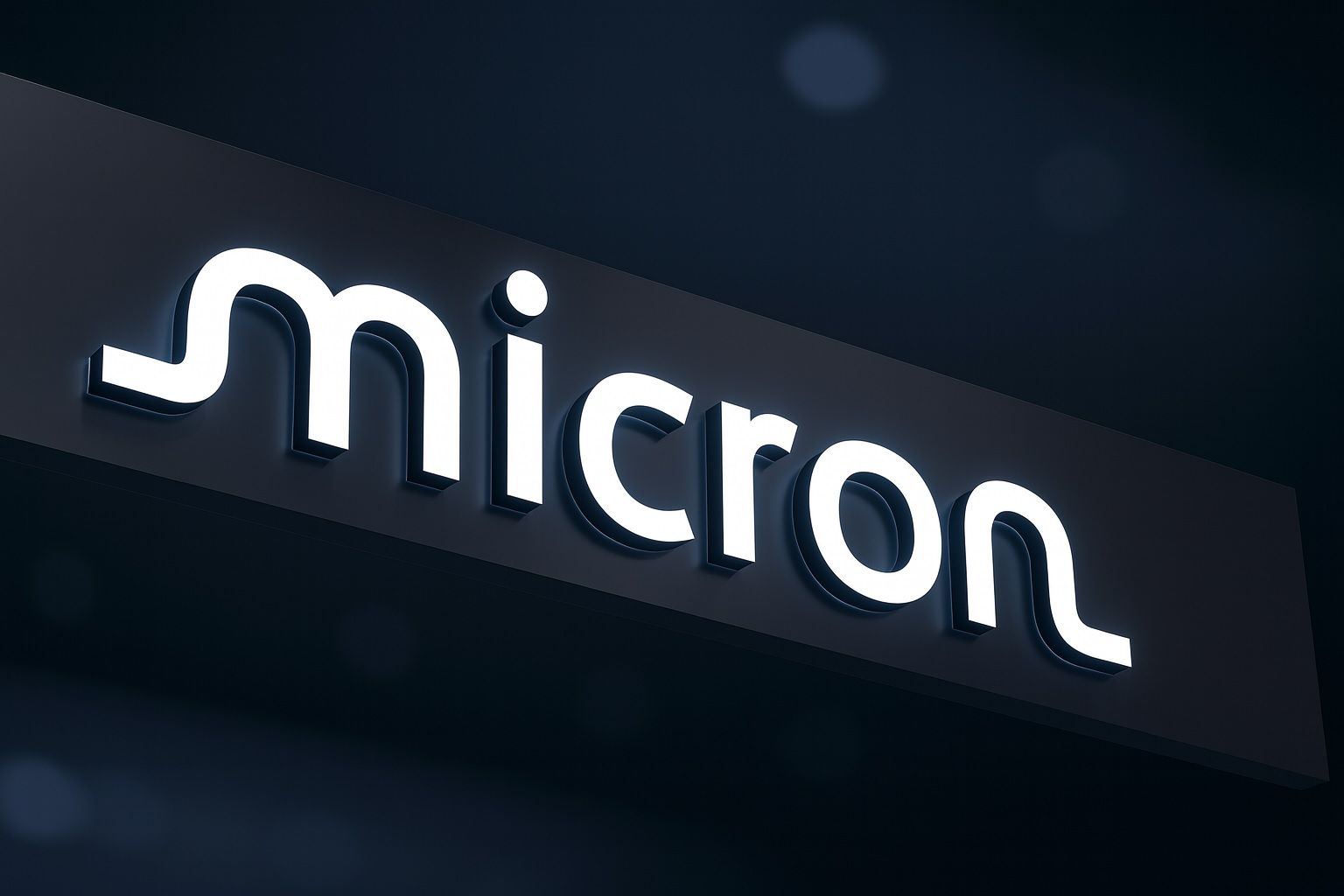- Soaring Share Price: Micron Technology’s stock has nearly doubled in 2025, recently hitting all-time highs around the $190–$200 range amid a frenzied AI-driven rally [1]. As of mid-October, MU trades near $192 after a year-to-date surge of over 100%, vastly outpacing the broader market.
- Blowout Earnings: Fiscal 2025 was a record year for Micron. In Q4 (Aug-ended) revenue jumped ~46% YoY to $11.32 billion and non-GAAP EPS hit $3.03 – both well above forecasts (~$11.1 B and $2.86) [2]. Full-year revenue reached $37.4 B (+49% YoY), with net income of $8.5 B, marking a dramatic rebound from the prior year’s slump.
- Strong Guidance: Micron issued bullish guidance for the current quarter (Q1 FY2026), projecting roughly $12.5 B in revenue and $3.7 EPS, blowing past Wall Street’s prior estimates (~$11.9 B, $3.0) [3]. This outlook implies ~35–40% YoY growth with gross margins expected above 50%, reflecting robust pricing power [4].
- AI Memory Boom: Explosive demand from artificial intelligence and cloud data centers is turbocharging Micron’s growth. High-Bandwidth Memory (HBM) chips – critical for AI servers – are effectively sold out, with roughly $2 B in HBM sales in Q4 alone [5] [6]. Micron’s AI-focused “Cloud Memory” revenues soared 213% last quarter, as data-center customers scramble for its high-end DRAM [7].
- Analysts Bullish: Wall Street is overwhelmingly positive on MU. Dozens of analysts rate it a Buy, and many have hiked price targets. UBS recently raised its 12-month target to $225, Morgan Stanley to $220, KeyBanc to $215, and BNP Paribas to a Street-high $270 [8]. The consensus analyst rating is “Strong Buy,” with ~26 Buy ratings vs only a few Holds and an average target in the high $180s to low $200s [9] [10].
- Valuation & Cycle Risks: Despite the rally, Micron’s valuation looks reasonable. The stock trades around 20× forward earnings, and its PEG ratio (~0.4) suggests it isn’t overpriced relative to its growth [11]. However, memory is a notoriously cyclical business – some experts warn a lot of the good news may be “baked in” to the stock already [12]. Investors should note potential risks like volatile memory pricing, new supply coming online from rivals, and geopolitical headwinds.
Stock Performance: AI Hype Sends Micron Soaring
Micron’s share price momentum in 2025 has been extraordinary. As of October, the stock has more than doubled from January levels, vastly outperforming the S&P 500 and even many tech peers [13]. The rally accelerated in late September and early October when Micron hit fresh record highs, peaking intraday above $196 and closing near $192 [14]. This surge reflects both company-specific optimism and broader “AI mania” lifting the semiconductor sector [15]. Investors have piled into AI-related stocks, and Micron – as a key supplier of memory for AI systems – has been a prime beneficiary [16].
Notably, the entire chip industry has boomed on AI enthusiasm; giants like NVIDIA have logged record highs, indirectly boosting Micron since every advanced AI processor requires vast amounts of memory [17]. Memory-focused rivals Samsung Electronics and SK Hynix have also seen their stocks soar to record levels this year amidst the chip upcycle [18]. Micron’s roughly +100% YTD gain actually outpaces many of these peers [19], underscoring how central it has become to the 2025 tech story.
However, Micron’s ride has not been without volatility. After touching ~$201 in early October, the stock pulled back to around $180 within days amid broader market jitters and U.S.–China trade concerns [20]. This quick drop – and subsequent rebound – highlights the stock’s sensitivity to news. Still, overall momentum remains firmly bullish, with high trading volumes (often 15–18 million shares daily in October, vs ~23M average [21]) signaling strong investor interest. Micron’s market capitalization now stands around $210 B, and it has firmly re-established itself as a market leader riding the AI wave.
Record Earnings Powered by AI Demand
Micron’s latest financial results have validated the market’s enthusiasm. In its fiscal Q4 2025 (reported late September), Micron shattered expectations: revenue hit $11.32 billion (a 46% YoY leap) and non-GAAP earnings were $3.03 per share, handily topping consensus (~$2.86) [22]. This capped Micron’s best year ever – FY2025 revenue of $37.38 B (+~49%) and GAAP EPS of $7.59 (vs only $0.70 in FY2024) [23] [24]. CEO Sanjay Mehrotra hailed it as a “record-breaking fiscal year,” highlighting Micron’s strong execution and “most competitive portfolio to date” going into FY2026 [25].
The driving force behind these stellar numbers is unprecedented demand from artificial intelligence applications. Data centers training AI models need enormous amounts of memory, especially advanced HBM (High-Bandwidth Memory) chips that Micron specializes in. Micron’s new AI-centric product lines are seeing explosive growth – its cloud/server memory segment saw revenues skyrocket 213% year-on-year in Q4 [26]. The company’s latest HBM3 and HBM3E chips (used alongside GPUs in AI supercomputers) are effectively sold out through next year, with Micron reporting nearly $2 B in HBM sales in just the last quarter [27]. This is a stunning turnaround from the memory glut of 2022–23; Micron has transformed from a struggling chipmaker to a high-growth leader as AI “claws for Micron’s memory” [28].
Crucially, this AI boom is also improving Micron’s profit margins. Many of these AI-tailored products carry premium pricing – Micron’s Q4 gross margin hit ~45.7%, up sharply from ~36.5% a year ago [29]. In fact, Q4 was the first time since 2018 that Micron’s gross margins exceeded 50% on a non-GAAP basis [30]. The company’s focus on higher-value markets (like data center DRAM, HBM, and automotive memory) and its exit from low-end commodity products (e.g. mobile NAND flash for smartphones) are paying off [31] [32]. Micron even cut ~300 jobs in its legacy NAND business as it pivots to more lucrative segments [33]. This strategic shift, combined with secular tailwinds from AI, has underpinned Micron’s historic rebound in revenue and profitability.
Bright Outlook: Robust Guidance and Growth Forecasts
Micron’s management expects the good times to continue into the new fiscal year. For the current quarter (FY2026 Q1), the company forecast revenue of ~$12.2–$12.8 B and adjusted EPS of $3.60–$3.90 [34]. These figures blew past Wall Street’s estimates (which were around $11.9 B and $3.10) [35]. At the midpoint, Micron is guiding for ~37% higher sales and ~30% higher EPS than the year-ago quarter – an acceleration of growth even on tough comparisons [36]. Such bullish guidance caught analysts by surprise; one noted the outlook “blew Wall Street’s expectations out of the water” [37]. It signals that Micron’s AI-fueled momentum is not abating.
Micron’s executives cited strong trends in both DRAM and NAND markets for 2026. They foresee continued tightness in DRAM supply (a positive for pricing) and even improvement in NAND flash, which had lagged but may recover with new tech nodes [38]. Micron is also ramping production of cutting-edge “1-gamma” DRAM chips in 2026, aiming to stay ahead on cost and performance [39]. Capital expenditures are set to rise to ~$18 B in 2026 (focused on DRAM fabs) to support this growth [40] [41] – a sign of confidence in sustained demand.
Industry forecasts support Micron’s optimism. Consensus analyst estimates predict Micron’s EPS will climb to around $16–$17 in FY2026 [42], roughly double the just-ended year’s earnings. Revenue is expected to keep growing at a double-digit pace. In other words, the Street believes the current upcycle has further to run, powered by secular drivers in AI, cloud, and 5G. Micron itself emphasizes that AI has “radically changed the landscape” for memory demand [43] – a trend unlikely to reverse soon. Barring an unforeseen macro downturn or glut, Micron appears poised for multiple strong quarters ahead.
Wall Street Analysts: Big Targets Amid Cycle Warnings
Analysts are almost unanimously bullish on Micron after its recent results. According to MarketBeat, 26 out of 30+ analysts now rate MU stock a Buy or Overweight, versus only a handful of Hold ratings [44] [45]. Price targets have been racing higher in recent weeks. For example:
- UBS lifted its 12-month target from $195 to $225 (on Oct 8, 2025) citing surging HBM memory demand [46].
- Morgan Stanley upgraded Micron to “Overweight” and set a $220 target (Oct 6) as analyst Joseph Moore argued there’s “more room to run” despite the stock’s 122% YTD rise [47] [48]. He noted Micron could see multiple quarters of double-digit memory price increases, translating to “substantially higher earnings power” ahead [49].
- KeyBanc (KeyCorp) raised its target to $215 (Overweight rating) [50], and Wedbush moved up to $200, highlighting Micron’s outlook is “underpinned by a strong memory cycle” with AI tailwinds extending the uptrend [51].
- BNP Paribas Exane made an aggressive call, upgrading MU to Outperform and projecting $270 per share [52] – a bullish outlier implying the stock could climb another ~40%.
Even after these hikes, Micron’s average price target sits around the high-$180s to ~$200 [53] [54], roughly in line with the current price. This suggests that while analysts see upside, the stock’s big rally has caught up to some of their models. Importantly, the consensus direction is still positive – numerous firms have issued fresh upgrades and higher targets in light of Micron’s AI-fueled earnings beat.
That said, not everyone is unabashedly bullish. A few voices urge caution, pointing to Micron’s history of boom-bust cycles. Morningstar recently kept a Neutral rating, praising Micron’s “exceptional” results but warning that “a lot of that upside is already baked in” to the stock price [55] [56]. Similarly, New Street Research just downgraded MU from Buy to Neutral (even as it maintained a $190 target) on the view that Micron now “trades at peak multiples.” The firm expects rising earnings will be offset by multiple compression, consistent with past cycle peaks, potentially resulting in “muted stock performance” going forward [57] [58]. New Street analysts noted Micron’s valuation is high relative to history and prefer TSMC for AI exposure with less cyclicality [59].
Additionally, some analysts highlight longer-term supply risks. Barclays and Citi, for instance, cautioned that investors may be “pricing in near-perfect execution” and that the currently tight HBM market could swing to oversupply by late 2026 as multiple chipmakers ramp up output [60] [61]. If competitors flood the market, memory prices could weaken and squeeze Micron’s margins. These cautions underscore that Micron’s ride, while rosy now, comes with cyclical risk. Overall, Wall Street’s tone is optimistic – Micron is seen as a primary winner of the AI revolution – but seasoned observers remind investors to temper expectations as the memory industry can turn quickly.
Technical Analysis: Momentum Strong, Watching Key Levels
From a technical chart perspective, Micron’s stock has been in a clear uptrend throughout 2025. The recent dip in early October appears to be a healthy pullback after a powerful run. All major moving averages are trending upward, and as of Oct 13, Investing.com’s technical summary rated MU a “Strong Buy” on all 12 tracked indicators. The stock’s 14-day RSI is around 58 – elevated but not yet in overbought territory [62] – suggesting there may be room for the rally to continue before momentum overheats.
Analysts have identified a crucial support zone around $175–$180 [63]. This area was previously a resistance in September and, notably, the stock bounced near $180 during the mid-October dip. Holding above $175 is seen as important for Micron to maintain its bullish trajectory [64]. According to FX Leaders, a sustained break below $175 could trigger a deeper correction toward the mid-$160s [65]. On the upside, resistance around $192–$200 is the hurdle to clear – essentially the recent peak zone. A move back above ~$193 would “restore bullish momentum,” technicians say, potentially paving the way for new highs [66].
In plain terms: Micron’s chart remains strong, with higher highs and higher lows, but traders are on watch for any signs of trend exhaustion. Short-term profit-taking or market volatility (for example, any negative news on China trade or tech sentiment) could cause swings. If the stock did pull back further, many bulls would view ~$160 (roughly where the 50-day moving average might lie) as an attractive buy-the-dip level. For now, the path of least resistance is upward – but vigilance is warranted given how far, and how fast, MU has climbed in 2025.
Fundamentals and Valuation: Growth vs. Cycles
On fundamental metrics, Micron’s story is one of dramatic improvement. After posting minimal profit in 2022’s downturn, the company delivered over $9 billion in non-GAAP net income in FY2025 [67]. Free cash flow turned strongly positive (~$3.7 B in FY25) and the balance sheet is healthy, with Micron holding roughly $8 B net cash after years of conservative management [68] [69]. The company even resumed shareholder returns, raising its dividend by 15% to $0.115/quarter (a token yield, but a sign of confidence) [70].
Despite this explosive earnings growth – Micron’s GAAP EPS jumped ~984% YoY in FY2025 [71] [72] – the stock’s valuation remains moderate. At ~$190 per share, MU trades around 20 times forward earnings, assuming FY2026 consensus EPS in the mid-teens [73]. A ~20× P/E for 30–40% growth is relatively modest; by comparison, many AI chip peers trade at far higher multiples. In fact, some analysts argue Micron is undervalued on a growth-adjusted basis. TechStock² (TS²) notes Micron’s PEG ratio (price/earnings-to-growth) is about 0.4, indicating the stock price isn’t keeping up with the earnings trajectory [74]. “Micron’s current valuation is not stretched given its growth,” the analysis concludes [75] [76].
That said, memory stocks typically command lower multiples for a reason: cyclicality. Micron’s earnings are expected to crest in this upcycle and then, eventually, decline when supply catches up with demand. The forward P/E of ~20× could compress if investors start bracing for a downturn in 2–3 years. Indeed, historically Micron has traded at mid-to-high single-digit P/Es at cycle troughs and low double-digits at peaks. The difference now is that secular trends (AI, automotive, data center) might sustain a higher “floor” for Micron’s sales and profits than in past cycles. Even if memory prices cool in a couple of years, Micron’s revenue base will likely be far above pre-2024 levels [77].
In summary, Micron’s fundamentals are arguably the strongest they’ve ever been – record revenues, fat margins, solid balance sheet – and the stock’s valuation reflects a mix of high growth and future risk. It’s not cheap in absolute terms (near 20× earnings and ~6× sales), but relative to its earnings boom and compared to richly valued AI hardware peers (like NVIDIA at ~40× forward earnings), Micron looks reasonably valued. The bull case is that Micron can grow into a higher valuation if the AI super-cycle extends through 2026 and beyond. The bear case is that memory pricing is at a peak and any slip could cause both earnings and the P/E multiple to decline, pressuring the stock. Investors thus must balance growth potential against cyclical reality when assessing Micron’s fundamentals.
Competitive Landscape: Micron vs. Peers
Micron operates in a highly concentrated memory chip industry. Its main competitors are South Korea’s Samsung Electronics and SK Hynix, which together with Micron form the “big three” of global memory suppliers [78]. Samsung is the market leader in both DRAM and NAND flash, while SK Hynix has aggressively grown and even overtook Samsung in DRAM market share at one point this year [79]. All three have enjoyed booming demand from AI and have seen their share prices soar in 2025 [80]. Micron’s DRAM market share is roughly third behind the two Korean giants, but Micron has been growing the fastest lately thanks to its focus on AI-oriented products [81].
One unique aspect: Micron is the only major U.S.-based memory manufacturer [82]. This has brought it strategic advantages – for example, the U.S. government has supported Micron through incentives like the CHIPS Act (Micron was awarded $6.2 B in grants to expand domestic production) [83]. Micron is investing that into new fabs in the U.S. and a $7B high-tech packaging plant in Singapore [84]. Being the lone American player also means Micron is at the center of geopolitical currents: it faces restrictions in China (which banned some Micron chips in critical infrastructure over security claims) [85], yet it benefits from U.S. and allied efforts to secure supply chains. This geopolitical positioning can be a double-edged sword – yielding government support but also exposure to trade tensions, as seen when China’s ban dented Micron’s China revenues (Micron has shifted focus to “friendlier” markets as a result) [86].
In terms of product focus, Micron has been reshaping its portfolio. It has pulled back from commodity NAND flash (where players like Western Digital and Kioxia lead) and doubled down on DRAM and HBM for data centers [87]. This plays to Micron’s strength and the high-margin opportunities in AI and cloud. Rival Samsung offers a broader portfolio (DRAM, NAND, logic chips, etc.), while SK Hynix has a strong position in both DRAM and next-gen memory like HBM (SK Hynix actually was first to market with some HBM generations). All are now racing to build new capacity – Samsung and Hynix have new fabs in the works – so Micron must keep innovating to stay competitive [88]. So far, Micron’s leap into HBM3E and its execution in ramping advanced nodes have kept it on par technologically.
It’s also worth noting that Micron’s “competitors” in the broader chip space (like NVIDIA, AMD, and Intel) are actually customers or partners when it comes to memory. For instance, NVIDIA’s AI GPUs require stacks of HBM memory (often supplied by Micron or Hynix), and AMD’s upcoming MI300/MI400 accelerators similarly will use HBM from memory makers. These CPU/GPU companies do not make their own DRAM; rather, their success fuels Micron’s growth [89]. As one analysis put it, Nvidia and AMD are not direct peers to Micron but their AI success has direct spillover benefits for memory demand [90]. Even Intel, which once dabbled in memory (through a NAND joint venture and Optane technology), has exited those businesses – leaving Micron as a key standalone memory supplier in the West. In fact, Micron’s unique position has made it something of a bellwether for how the AI revolution translates into memory market value, as it sits at the intersection of cutting-edge compute and the storage it requires [91].
Short-Term Outlook: Rally vs. Retracement
In the short term, most experts believe Micron will weather any dips and potentially push higher, albeit with some volatility. The AI demand story provides a strong tailwind, and Micron’s own guidance and analyst revisions suggest further earnings beats could be coming [92]. As long as Micron’s results continue to top expectations, the stock could see another leg up. Several analysts have pointed out that any near-term weakness might present a buying opportunity. “Given the strength of the AI-driven trend, many strategists see MU holding above support and aiming for its recent highs,” noted TS², adding that a sustained break back into the high-$190s could open the door to new all-time highs [93] [94].
Near term, market technicians are watching $200 as the next psychological and technical barrier. If Micron climbs above $200 with conviction (its prior peak is ~$196.50 closing, ~$201 intraday), it would signal a fresh breakout. On the downside, as discussed, ~$175 is key support – a level at which Micron might attract dip buyers given the fundamentally strong outlook [95]. Broad market conditions will also play a role; for example, rising interest rates or rotation out of tech could temporarily cap Micron’s rally despite its own performance. But absent a macro shock, the consensus 1-year targets in the $200+ range imply that analysts see Micron stock grinding higher over the coming months [96] [97].
Some short-term risks include the possibility of profit-taking after Micron’s huge YTD run, and any negative news on U.S.–China relations (e.g. new export controls on chip tech or Chinese retaliations) which tend to spook semiconductor stocks in general. We saw an example of this in mid-October: despite strong fundamentals, Micron’s stock slipped ~3% in one day amid reports of escalating trade tensions and an analyst downgrade [98]. Events like that could spark brief pullbacks. Overall though, the near-term bias remains bullish, with many believing that as long as AI demand stays red-hot, Micron will likely revisit $200+ in the not-too-distant future.
Long-Term Outlook: Big Opportunities – and Challenges
Looking further out, Micron’s trajectory will hinge on how the memory cycle evolves and how well the company executes on technology and capacity expansion. The structural trend appears favorable: Artificial intelligence, cloud computing, and 5G/edge devices are expected to drive secular growth in memory consumption for years to come [99]. Data center operators and AI developers show no sign of slowing their investments – if anything, memory is becoming more central (e.g. larger AI models require exponentially more memory). Micron’s CEO Mehrotra has emphasized that the company is “uniquely positioned to capitalize on the AI opportunity ahead” [100], given its cutting-edge products and the backing it has to build new fabs. Government policies like the CHIPS Act in the U.S. also suggest Micron will have support in expanding capacity to meet future demand [101] [102].
Most long-term forecasts see Micron’s revenues and earnings continuing to rise through at least 2026 [103]. By late this decade, additional supply from competitors could moderate prices, leading to a more normalized (but still healthy) profit level. Even in a “down” phase, analysts believe Micron’s earnings in, say, 2027–28 would remain well above the troughs of past cycles [104]. This is because the floor of memory demand is ratcheting higher thanks to AI, automotive (where modern cars use tons of memory), and IoT. In essence, Micron’s long-term outlook is robust if it can maintain technology leadership and cost efficiency.
Key opportunities ahead include Micron’s development of next-gen memory like HBM4E and beyond – staying at the cutting edge could allow it to command premium pricing. The company is also investing in new 3D DRAM architectures and possibly exploring emerging memory types (it mentioned MRAM as an emerging area) [105]. If Micron succeeds in these, it can capture growing niches and differentiate from rivals. Another opportunity is the potential recovery of NAND flash: Micron scaled back here, but if the NAND market rebounds strongly (e.g. due to new demand from data centers or a competitor merger reducing supply), Micron could benefit with improved profitability on its remaining flash business.
On the risk side long-term, one looming challenge is that competition is ramping up capacity aggressively. Samsung and SK Hynix are pouring billions into new fabs, and China is also striving to build its own memory industry (though facing tech restrictions) [106]. By 2026–2027, the risk is the industry shifts from shortage to oversupply, which historically leads to steep price declines. Investors must be wary that today’s record prices and margins invite supply response. Micron will need to execute well on cost reductions (to maintain margins if prices fall) and on product differentiation (to avoid commodity status).
Another risk is geopolitical uncertainty. The U.S.–China tech conflict puts Micron in a delicate spot: China was ~10% of Micron’s sales and remains a huge end-market for electronics that use Micron chips. Restrictions, like China’s ban on Micron in certain sectors [107] or potential U.S. export controls on memory technology, could impact Micron’s addressable market. Thus far Micron has navigated these waters by shifting focus and leveraging support from other regions, but it’s a factor to watch.
Economic cycles are a risk as well – memory demand correlates with global GDP and IT spending. A recession or downcycle in tech spending could soften demand for Micron’s products even if AI remains a secular theme. Additionally, any delays or issues in Micron’s own manufacturing roadmaps (for instance, if a new DRAM node yields poorly or a fab expansion gets delayed) could set it back against competitors.
In summary, Micron’s long-term thesis is strongly positive: the company sits at the heart of the AI revolution with products that are essential for the future of computing. If it continues executing, Micron could enjoy several more years of growth and high profitability, solidifying its status as an industry leader. Experts foresee a multi-year upcycle, albeit with the acknowledgement that today’s euphoric conditions won’t last forever [108]. Even the bulls concede that Micron’s current valuation assumes a lot of success – any stumble or a turn in the cycle could lead to a sharp correction. Therefore, while long-term upside is seen as compelling, savvy investors will monitor indicators like supply conditions, inventory levels, and price trends for any early signs that the memory market’s fever may be breaking [109] [110].
Investment Risks and Opportunities
Opportunities: Micron stands to gain enormously from several ongoing trends. The AI and cloud computing boom is the biggest catalyst – as long as companies like NVIDIA, OpenAI, and cloud providers are racing to build AI supercomputers, Micron will be selling them the high-end memory to do it. The company’s strong footing in HBM and advanced DRAM gives it a technological edge in this arena. Moreover, Micron’s status as a U.S. champion in a critical industry means it enjoys substantial government support (grants, incentives) that can fuel expansion [111]. Another opportunity is Micron’s focus on high-growth segments like automotive and industrial memory – for example, self-driving cars and edge devices need ever more memory, a market Micron is well-positioned to serve. If Micron executes its $40 B capital investment plan effectively, it could capture outsized share in these growth markets while competitors play catch-up [112]. Long-term, the continued digitization of everything from AI to 5G to IoT suggests secular growth for memory – a tide that should lift Micron for years, even if there are waves along the way.
Risks: Despite the upbeat outlook, investors should be mindful of key risks. The foremost is the cyclical nature of the memory chip industry. Booms are often followed by gluts; prices that rise can also fall, sometimes sharply. Micron’s current upswing will eventually moderate – the question is when and how abruptly. If competitors overbuild capacity (as history has seen), the market could swing to oversupply by 2026 or 2027, hurting Micron’s pricing power [113]. In fact, some analysts warn that the HBM shortages today could turn into HBM oversupply in a couple of years [114].
Another risk is valuation expectations. Micron’s stock now reflects substantial success. As New Street Research noted, the stock is trading at cycle-peak valuations [115], which implies limited margin for error. Any disappointment – whether a demand hiccup or slightly weaker gross margin – could trigger outsized stock declines as investors recalibrate growth expectations. Geopolitical risk is also significant: Micron is caught in the U.S.–China tech tussle. Further restrictions (for instance, U.S. banning AI chip sales to China, or China limiting exports of critical materials) could indirectly impact Micron’s business or sentiment toward chip stocks. Micron already lost some China revenue due to government bans [116], and it must constantly manage its global supply chain amid export controls.
Competition poses a risk as well – Samsung and SK Hynix are formidable, well-funded rivals. If they out-innovate Micron (for example, rolling out a breakthrough memory technology or undercutting on price), Micron could lose share or see its margins erode. There’s also emerging competition from China’s YMTC and CXMT in NAND and DRAM respectively, which, while not yet at Micron’s level, could make strides especially if Chinese firms are bolstered by government support (in response to Western restrictions).
Finally, macroeconomic and market factors – high interest rates, economic slowdowns, or a rotation out of tech – are general risks that could weigh on Micron’s stock irrespective of its operational performance. Micron’s beta is high, meaning it can swing more than the market on broader market moves.
Bottom Line: Micron Technology has entered a sweet spot with the AI revolution turbocharging its business. The stock’s record run in 2025 reflects justified optimism: Micron’s fundamentals have turned decisively positive, and many on Wall Street believe more gains lie ahead [117] [118]. However, this optimism is tempered by the knowledge that “trees don’t grow to the sky” in the semiconductor world. Memory cycles will ebb and flow, so investors should stay alert. In the near term, Micron’s outlook is one of strong growth and bullish sentiment, with the company at the center of a generational tech wave. Longer-term, it offers an attractive growth story but with cyclical caveats. For now, Micron appears to be in a historic upcycle – and if AI demand remains as voracious as it is today, MU’s rally may well have further to go, even as prudent investors keep an eye on the risks ahead [119].
Sources: Recent Micron news and analysis from TechStock² (ts2.tech) [120] [121] [122], Investing.com [123] [124], FX Leaders [125] [126], Yahoo Finance/TipRanks [127], Micron’s investor reports [128], and other financial media.
References
1. ts2.tech, 2. ts2.tech, 3. ts2.tech, 4. ts2.tech, 5. ts2.tech, 6. ts2.tech, 7. ts2.tech, 8. ts2.tech, 9. ts2.tech, 10. www.tipranks.com, 11. ts2.tech, 12. ts2.tech, 13. ts2.tech, 14. ts2.tech, 15. ts2.tech, 16. ts2.tech, 17. ts2.tech, 18. ts2.tech, 19. ts2.tech, 20. ts2.tech, 21. www.morningstar.com, 22. ts2.tech, 23. ts2.tech, 24. ts2.tech, 25. ts2.tech, 26. ts2.tech, 27. ts2.tech, 28. ts2.tech, 29. ts2.tech, 30. www.investing.com, 31. ts2.tech, 32. ts2.tech, 33. ts2.tech, 34. www.tipranks.com, 35. www.tipranks.com, 36. ts2.tech, 37. ts2.tech, 38. www.investing.com, 39. www.investing.com, 40. www.investing.com, 41. www.investing.com, 42. www.investing.com, 43. www.investing.com, 44. ts2.tech, 45. www.tipranks.com, 46. ts2.tech, 47. www.tipranks.com, 48. www.tipranks.com, 49. www.tipranks.com, 50. ts2.tech, 51. ts2.tech, 52. ts2.tech, 53. ts2.tech, 54. www.tipranks.com, 55. ts2.tech, 56. ts2.tech, 57. www.investing.com, 58. www.investing.com, 59. www.investing.com, 60. www.fxleaders.com, 61. www.fxleaders.com, 62. ts2.tech, 63. ts2.tech, 64. ts2.tech, 65. ts2.tech, 66. ts2.tech, 67. ts2.tech, 68. ts2.tech, 69. ts2.tech, 70. ts2.tech, 71. ts2.tech, 72. ts2.tech, 73. ts2.tech, 74. ts2.tech, 75. ts2.tech, 76. ts2.tech, 77. ts2.tech, 78. ts2.tech, 79. ts2.tech, 80. ts2.tech, 81. ts2.tech, 82. ts2.tech, 83. ts2.tech, 84. ts2.tech, 85. ts2.tech, 86. ts2.tech, 87. ts2.tech, 88. ts2.tech, 89. ts2.tech, 90. ts2.tech, 91. www.fxleaders.com, 92. www.investing.com, 93. ts2.tech, 94. ts2.tech, 95. ts2.tech, 96. www.tipranks.com, 97. www.tipranks.com, 98. www.investing.com, 99. ts2.tech, 100. ts2.tech, 101. ts2.tech, 102. ts2.tech, 103. ts2.tech, 104. ts2.tech, 105. ts2.tech, 106. ts2.tech, 107. ts2.tech, 108. ts2.tech, 109. ts2.tech, 110. ts2.tech, 111. ts2.tech, 112. ts2.tech, 113. www.fxleaders.com, 114. www.fxleaders.com, 115. www.investing.com, 116. ts2.tech, 117. ts2.tech, 118. ts2.tech, 119. ts2.tech, 120. ts2.tech, 121. ts2.tech, 122. ts2.tech, 123. www.investing.com, 124. www.investing.com, 125. ts2.tech, 126. ts2.tech, 127. www.tipranks.com, 128. ts2.tech







